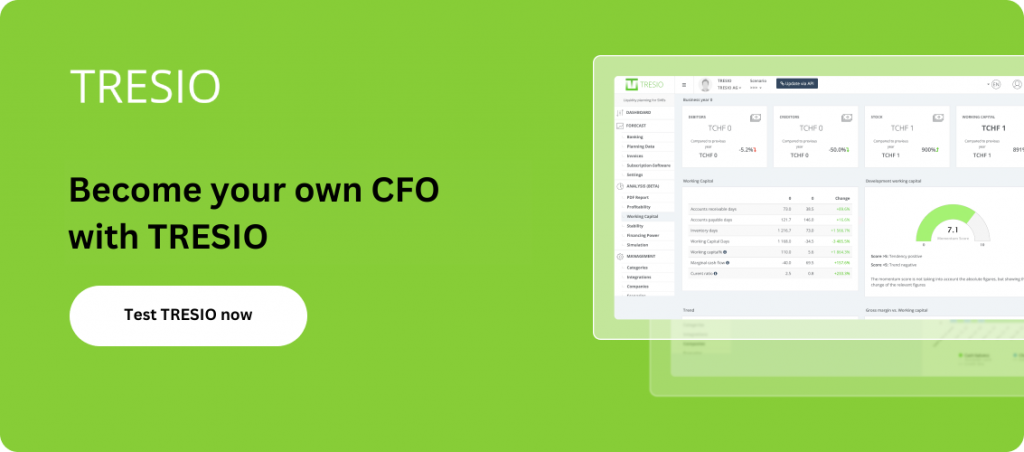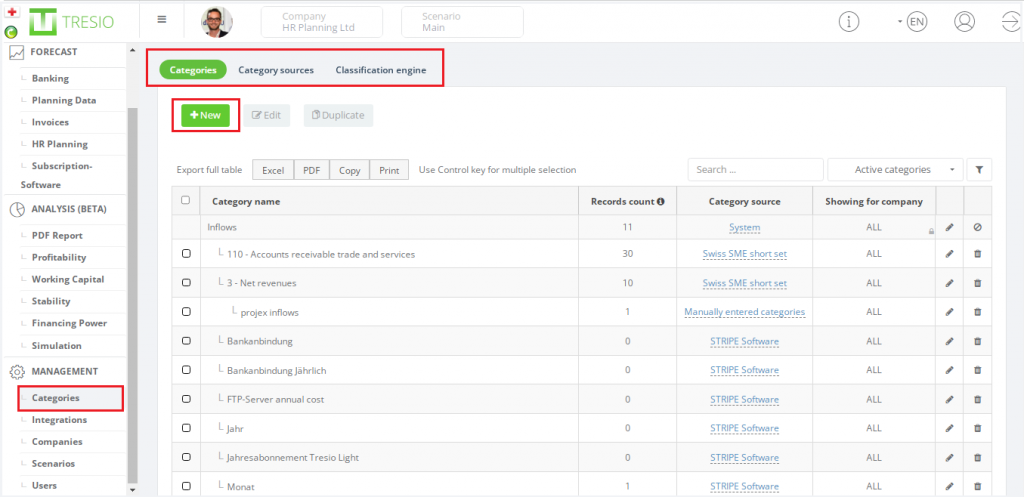In this article, we give as comprehensive an overview as possible of the category logic in Tresio. Attention: the article is aimed at the experienced users among you! Our team will be happy to help you with any questions you may have as part of the agreed support services .
All expenses and income are assigned to a category for liquidity planning and reporting (coming soon).
As part of our last system update, the category logic in Tresio was completely updated: subcategories can now also be added with just a few clicks.
Using the category groups, it is possible to customize categories very quickly and, for example, adapt them to the Swiss SME standard accounting framework or import them directly from connected accounting solutions such as Bexio or STRIPE .
This means that cost centres or project assignments, for example, can be mapped much more easily than before.
This article provides an overview of how categories are handled in Tresio.

Contents:
- Structure and basic settings
- Category management and subcategories
- Category Sources and Source Names
- Import of the accounting framework from Bexio
- FAQs
1. Structure and basic settings
The categories are managed in Tresio under MANAGEMENT -> Categories.

- Under ‘Categories’ you can see which categories you are currently using in Tresio. New categories and subcategories can also be entered here by clicking on the ‘New’ button.
- Under ‘Category Sources‘ you can define which category sources should be used.
- Categories can be reclassified under ‘Classification engine’ .
2. Category management and subcategories
The currently active categories can be seen under ‘Categories’.
You can also add additional categories and subcategories here, and disable or remove unwanted categories.
Let’s assume that our example company is a trading company with three main product groups. The company also sells service contracts.
The standard SME plan without adjustment looks like this:

For our example company, it would be exciting to see the income per product group (A, B and C) individually and also to show the services separately.
These should be attached as sub-categories under ’30 – Production yield’.
This can be achieved by capturing subcategories accordingly:
Collection of sub-categories
New categories and subcategories are easily entered by clicking on ‘New’ button:

- The account number (optional, in this case it is – 301) and the desired name of the (sub)category are entered under ‘Category name’
- For the ‘Category parent’ , the category above is recorded
- ‘Showing for company‘ – In the case of an account with several companies, new categories can be added for individually selected companies or “globally” if all companies selected
- The ‘Category comment‘ (optional) – comments for internal specifications can be entered here
- ‘Is fixed‘ and ‘Data sign conversion rule‘ are explained in more detail in section 5: FAQs
The adapted category structure for our example company is now as follows:


3. Category Sources and Source Names
Below is an overview of how to use this screen:

There are different Source names (1) in Tresio. These can be flexibly activated or deactivated at any time, or only parts of them can be used.
Examples of this are the ‘Tresio standard set’ (recommended), ‘Swiss SME short set’ – the SME list of accounts, or ‘Bexio Software’ – the list of accounts imported directly from Bexio.
Status (2) shows which categories are activated.
In the example shown, the ‘Swiss SME short set’ (Switzerland) is activated in an expanded manner, 45 categories were taken from it and shown in the ‘Category count’ (3) column, and these are used at the time of the screenshot for 102 data records (invoices, planning data, etc.) and shown in the ‘Records count‘(4) column.
Under ‘Unused category count‘ (5) you can also see that 5 other categories from this category group could be activated in Tresio.
Clicking on ‘view categories’ (6) opens the following window, in which you can specify which categories should be used in Tresio for each activated category group:


4. Import of the accounting framework from Bexio
Import of the accounting framework from Bexio and STRIPE
Bexio customers: Great news! The accounting framework used in Bexio is now imported directly into Tresio and can be used for budget and liquidity planning in Tresio.
There are basically two options:
a) Only accounts from Bexio that are used (e.g. via invoice import) are transferred (recommended)
b) the complete list of accounts is imported from Bexio .
The two options are described in more detail below:
a) Import of the accounts from Bexio that are actually used (recommended) :
1. Navigate to Categories -> Category Settings in Tresio
2. Under “Bexio Software” change the Status to “Create automatically”.
The Bexio accounts are then automatically supplied with every invoice import. There is nothing more to do.
b) Import of the complete list of sources from Bexio into Tresio:
- Navigate to ‘Categories’ -> ‘Category Settings’ in Tresio
- Select ‘Bexio Software’ source -> ‘Configure’
- A pop-up then opens with the options ‘Import categories’ and ‘Category remap’ .
-> all bexio accounts are imported with ‘Import categories’ . However, existing data records in Tresio are not changed.
-> ‘Category remap‘ is used to define how the existing categories in Tresio should behave with the new categories from Bexio. - The (re-)mapping required for this takes place under the ‘Classification engine‘ menu item :

Classification rules define which categories in Tresio the accounts imported from Bexio should correspond to.
5. FAQs
When managing categories and subcategories, what does the ‘Is fixed‘ check box mean?
Activate this check box if cash flows are planned in this category, but there are no invoices. Examples of this are permanent order leasing, wage payments, rent and loan repayments. These cash flows are taken into account in both plan and actual data.
What do the settings in the Data sign conversion rule do?
With the data sign conversion rule we define how positive and negative numbers should be handled.
There are three options to choose from:
- Don’t convert: in this case, negative numbers are treated as minus (ie subtracted from the total) and positive ones as plus
- Always positive: Numbers are added, regardless of whether there is a minus sign in front of them. In some accounting systems, this can be relevant for accounts payable, for example, if they come with a negative sign
- Always negative: Numbers are treated as negative, regardless of the preceding sign
Some plan data is shown as unclassified – what does this mean?
- Go to ‘Management’ -> ‘Categories’ -> ‘Clasification engine‘.
- Check that all old categories have been correctly transferred to the new categories.
- Any green Apply fields should be greyed out.
- Likewise, a new category should be recorded for all entries. If this is not the case -> use the dropdown to assign a suitable category.
I have a completely different structure than the category logic suggested here – how do I proceed?
Under ‘Management’ -> ‘Categories‘ you can select and delete individual entries by clicking on the check box on the left of the table, or all entries by clicking on the top-left of the table.
You can then create your own structure and logic as you see fit.









